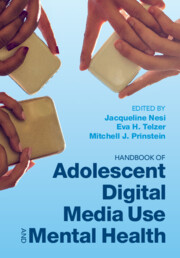Book contents
- Handbook of Adolescent Digital Media Use and Mental Health
- Handbook of Adolescent Digital Media Use and Mental Health
- Copyright page
- Dedication
- Contents
- Figures
- Tables
- About the Editors
- Contributors
- Acknowledgments
- Introduction
- Part I Theoretical and Methodological Foundations in Digital Media Research and Adolescent Mental Health
- Part II Digital Media in the Adolescent Developmental Context
- Part III Digital Media and Adolescent Mental Disorders
- Part IV Intervention and Prevention in the Digital Age
- Index
Index
Published online by Cambridge University Press: 30 June 2022
- Handbook of Adolescent Digital Media Use and Mental Health
- Handbook of Adolescent Digital Media Use and Mental Health
- Copyright page
- Dedication
- Contents
- Figures
- Tables
- About the Editors
- Contributors
- Acknowledgments
- Introduction
- Part I Theoretical and Methodological Foundations in Digital Media Research and Adolescent Mental Health
- Part II Digital Media in the Adolescent Developmental Context
- Part III Digital Media and Adolescent Mental Disorders
- Part IV Intervention and Prevention in the Digital Age
- Index
Summary
- Type
- Chapter
- Information
- Handbook of Adolescent Digital Media Use and Mental Health , pp. 417 - 438Publisher: Cambridge University PressPrint publication year: 2022
- Creative Commons
- This content is Open Access and distributed under the terms of the Creative Commons Attribution licence CC-BY-NC-ND 4.0 https://creativecommons.org/cclicenses/



